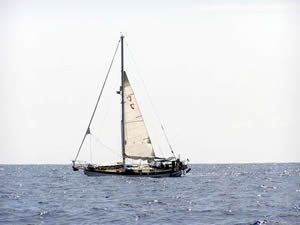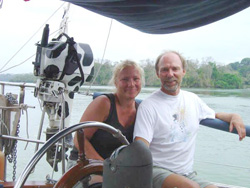SV Sailabout

The Sailing Vessel Sailabout in better times.

Capt. Gunner and Grethe
|
MAYDAY - Apr 5, 2007
On Friday May 4, 2007, at approximately 1340z, a
"MAYDAY" call was relayed to the Intercon
Net Control station, Wes KIØA in Tyler TX, by Sonny N5OTB on SV Valentina and Doug W7DUG.
W7DUG and N5OTB reported the vessel as
SV Sailabout (non-ham) was calling mayday on the frequency
but, due to propagation conditions, was not being answered. KIØA did not have very good copy on
Sailabout so he
handed the frequency to Fletcher KA4BPR, in Dothan AL.
Sailabout was a 35' vessel, Norwegian flagged, with two people
onboard, Capt. Gunnar and Grethe.
With the assistance of relay stations, the position of the
Sailabout was determined to be approximately 05-53.0S
x 100-46.0W, or about 700 miles south-west of the Galapagos Islands. It was also determined that
Sailabout had suffered
damage to the bow when the forestay was lost. At this time,
Sailabout reported that they were taking-on water and
had about one meter in the boat but the pumps were working.
Sailabout reported that the seas were six to eight
feet with 16-18 knot winds out of the south-east. Capt. Gunnar was also concerned that the mast may come down which, aside
from the obvious damage, would also take down the radio antenna.
USCG Alameda was notified and apprised of the situation. KA4BPR was assisted by many other stations in gathering and relaying
critical information for the USCG.
At 1425z, at the request of the USCG,
Sailabout activated their EPIRB and the signal was received and plotted. USCG
were able to contact and divert two vessels to the assistance of Sailabout. The commercial vessels were the MV Belnor and
MV Ivory Dawn. However, both vessels estimated a significant period of time before they could arrive at
Sailabout.
Two private sailing vessels also changed course and began to head to Sailabout's assistance. They were Colleen and Tom on
SV Mokisha (non-ham) and Ute and Paul M0PWJ on SV Damarri. Damarri estimated five hours while Mokisha estimated 12 - 14 hours.
Ultimately, Mokisha had to abandon their efforts as they were battling headwinds and high seas and not making any progress.
Sailabout was able to get underway and changed course towards Damarri. The net maintained a regular radio schedule
with both vessels and updated the USCG, as they did not have direct communication with Sailabout.
At approximately 2200z, arrangements were made by the USCG to have an Navy Orion P3 aircraft make an air drop to the
Sailabout with
a life raft and other survival gear. It was estimated that this would occur at 0400z (May 5). Damarri estimated that he would
be at Sailabout before the air drop. Damarri reported that the seas were now 12 to 14 feet with strong winds. However,
it was clear from the updated positions that both vessels were closing on each other.
Sailabout reported that he had some external lighting still working on the vessel and some red flares. The Capt.
will use them to alert the P3. Damarri advises that he has a strobe light which will also be used to attract the P3.
At 0137z (May 5) Damarri reported that he has made visual and VHF radio contact with the
Sailabout. Damarri did
not attempt to transfer the two people from Sailabout due to the wind and sea conditions. Damarri stood-off approximately
1nm from
Sailabout, to avoid a collision. All was reasonably well onboard both vessels, although both crews were
extremely fatigued.
Sailabout reported the leak was still under control but the mast is of greatest concern.
Sailabout was advised by USCG, via the net, to begin monitoring VHF channel 16 at 0330z for the P3 aircraft. Also,
when they hear the plane in the sky, to shoot up a flare. Sailabout was also advised that MV Belnor is still enroute and
expected around 1500z.
At 0245z, the MMSN secures for the night as propagation is all but gone.
At 1100z, the Intercon Net resumed operations and communication with Dumarri was re-established by the relay stations. Both
vessels are standing-by for the Belnor and their situation was unchanged. We learned that the air drop was not made, for
various reasons. The net maintained a radio schedule with the vessels and updated the USCG with position and condition reports
throughout the morning.
At 1530z, SV Damarri confirmed that MV Belnor had arrived and transferred both persons from
Sailabout to Belnor.
Sailabout was
abandoned at sea. This occurred at 05-07.5N x 101-23.8W. The Belnor was going to take Gunar and Grethe to Panama while Damarri
continued onto the Marqueses.
The net received significant assistance from Gene KI4EYF on SV Queen Mary, in Honduras. Gene had good copy on all vessels
and net control stations and he was able to relay critical information, updates and instructions to and from the vessels.
Without Gene's assistance, this situation would have been much more difficult to deal with under the poor radio conditions.
Well done Gene!
Also, Al on SV Griffith (WDB6077) and Bob KB1DEC on SV Shamal kept the family of
Sailabout in Norway advised via
telephone. The net also received assistance from Judy and Greg aboard SV Lone Star Love (WDB6076) with some relay assistance.
Considerable thanks to Beryl VP5DB (Provo, T&C Islands), Dale KR4OR (Miami, FL) and Bob K5SIV (Austin, TX). These three
stations were on-the-air for most of the incident and they, with the assistance of other net control stations, maintained
communication with the USCG and the vessels and relays. There were several other controllers who assisted with the incident
and many thanks go out to them. There are just too many to list!
However, to the hundreds (maybe thousands?) of other stations that were monitoring the incident but never transmitted,
THANK-YOU for
having the discipline not to transmit and keeping the frequency clear. This kind of work is never easy but a clear frequency
is extremely important. It is possible to have too much help and that is just as bad, if not worse, than not enough help.
Thank-you to everyone!
73 and best regards...
Tom VE3II
Assistant Manager
Maritime Mobile Service Network